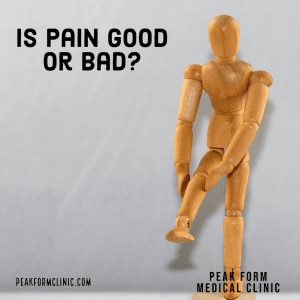 “No pain, no gain!” Well, sometimes that’s true, though not always.
“No pain, no gain!” Well, sometimes that’s true, though not always.
There is pain that elicits change, and pain that indicates a problem. How can you tell the difference between the two? As physical therapists, we ask you a lot of questions about pain. We ask how severe it is, if it burns/aches/shoots, when it happens, or how long it takes to subside. Why do we nag you with so many questions?
Good Pain
After a good workout, your muscles can get sore. They may feel stiff but improve with stretching and movement. Typically both sides feel sore (both shoulders, both legs). This is a type of pain that we consider “good.”
Additionally, in therapy we might work with you on exercises that feel uncomfortable. Generally, we don’t want you to feel pain above a moderate level. There is some evidence to suggest that a little pain during therapy is beneficial, but there is a limit.
Bad Pain
This is the kind of pain that you need to listen to and not “push through.” Bad pain tends to be sharp or shooting, may be accompanied by clicking, popping, or swelling, and tends to linger. It may also keep you awake at night, whereas muscle soreness likely doesn’t.
Another factor to consider is whether you feel this type of pain on one side and not the other. This can indicate something is off. If it gets worse as you “push through,” this is a sign to stop.
Does something hurt and you’re not sure what to do?
Come and see us for an evaluation! We’ve said it before: don’t feel like you need to suffer alone. A “wait and see” approach isn’t always best; the earlier you get in to physical therapy, the sooner you’ll be back to normal.

